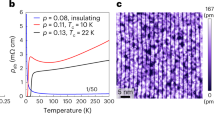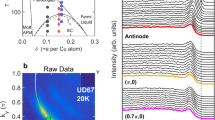Abstract
Superconductors are characterized by an energy gap that represents the energy needed to break the pairs of electrons (Cooper pairs) apart. At temperatures considerably above those associated with superconductivity, the high-transition-temperature copper oxides have an additional ‘pseudogap’. It has been unclear whether this represents preformed pairs of electrons that have not achieved the coherence necessary for superconductivity, or whether it reflects some alternative ground state that competes with superconductivity1. Paired electrons should display particle–hole symmetry with respect to the Fermi level (the energy of the highest occupied level in the electronic system), but competing states2,3,4 need not show such symmetry. Here we report a photoemission study of the underdoped copper oxide Bi2Sr2CaCu2O8+δ that shows the opening of a symmetric gap only in the anti-nodal region, contrary to the expectation that pairing would take place in the nodal region. It is therefore evident that the pseudogap does reflect the formation of preformed pairs of electrons and that the pairing occurs only in well-defined directions of the underlying lattice.
This is a preview of subscription content, access via your institution
Access options
Subscribe to this journal
Receive 51 print issues and online access
$199.00 per year
only $3.90 per issue
Buy this article
- Purchase on Springer Link
- Instant access to full article PDF
Prices may be subject to local taxes which are calculated during checkout




Similar content being viewed by others
References
Timusk, T. & Statt, B. The pseudogap in high-temperature superconductors: an experimental survey. Rep. Prog. Phys. 62, 61–122 (1999)
Valla, T. et al. Quasiparticle spectra, charge-density waves, superconductivity, and electron-phonon coupling in 2H-NbSe2 . Phys. Rev. Lett. 92, 086401 (2004)
Schäfer, J. et al. Direct spectroscopic observation of the energy gap formation in the spin density wave phase transition at the Cr(110) surface. Phys. Rev. Lett. 83, 2069–2072 (1999)
Chakravarty, S., Laughlin, R. B., Morr, D. K. & Nayak, C. Hidden order in the cuprates. Phys. Rev. B 63, 094503 (2001)
Damascelli, A., Hussain, Z. & Shen, Z.-X. Angle-resolved photoemission studies of the cuprate superconductors. Rev. Mod. Phys. 75, 473–541 (2003)
Lee, W. S. et al. Abrupt onset of a second energy gap at the superconducting transition of underdoped Bi2212. Nature 450, 81–84 (2007)
Valla, T., Fedorov, A. V., Lee, J., Davis, J. C. & Gu, G. D. The ground state of the pseudogap in cuprate superconductors. Science 314, 1914–1916 (2006)
Tanaka, K. et al. Distinct Fermi-momentum-dependent energy gaps in deeply underdoped Bi2212. Science 314, 1910–1913 (2006)
Kanigel, A. et al. Evolution of the pseudogap from Fermi arcs to the nodal liquid. Nature Phys. 2, 447–451 (2006)
Norman, M. R. et al. Modeling the Fermi arc in underdoped cuprates. Phys. Rev. B 76, 174501 (2007)
Norman, M. R. et al. Destruction of the Fermi surface in underdoped high-T c superconductors. Nature 392, 157–160 (1998)
Kisker, E. et al. Evidence for the high-spin to low-spin state transition in ordered Fe3Pt Invar. Phys. Rev. Lett. 58, 1784–1787 (1987)
Greber, T. et al. Photoemission above the Fermi level: the top of the minority d band in nickel. Phys. Rev. Lett. 79, 4465–4468 (1997)
Matsui, H. et al. BCS-like Bogoliubov quasiparticles in high-T C superconductors observed by angle-resolved photoemission spectroscopy. Phys. Rev. Lett. 90, 217002 (2003)
Lucy, L. B. An iterative technique for the rectification of observed distributions. Astron. J. 79, 745–754 (1974)
Matsui, H. et al. Angle-resolved photoemission spectroscopy of the antiferromagnetic superconductor Nd1. 87Ce0. 13CuO4: anisotropic spin-correlation gap, pseudogap, and the induced quasiparticle mass enhancement. Phys. Rev. Lett. 94, 047005 (2005)
Chakravarty, S. et al. Angle-resolved photoemission spectra in the cuprates from the d-density wave theory. Phys. Rev. B 68, 100504 (2003)
Wen, X. G. & Lee, P. A. Theory of quasiparticles in the underdoped high-T C superconducting state. Phys. Rev. Lett. 80, 2193–2196 (1998)
Konik, R. M., Rice, T. M. & Tsvelik, A. M. Doped spin liquid: Luttinger sum rule and low temperature order. Phys. Rev. Lett. 96, 086407 (2006)
Yang, K. Y., Rice, T. M. & Zhang, F. C. Phenomenological theory of the pseudogap state. Phys. Rev. B 73, 174501 (2006)
Xu, Z. A. et al. Vortex-like excitations and the onset of superconducting phase fluctuation in underdoped La2-x Sr x CuO4 . Nature 406, 486–488 (2000)
Wang, Y. et al. Field-enhanced diamagnetism in the pseudogap state of the cuprate Bi2Sr2CaCu2O8+d superconductor in an intense magnetic field. Phys. Rev. Lett. 95, 247002 (2005)
Wang, Y., Li, L. & Ong, N. P. Nernst effect in high-T C superconductors. Phys. Rev. B 73, 024510 (2006)
Emery, V. J., Kivelson, S. A. & Zachar, O. Spin-gap proximity effect mechanism of high-temperature superconductivity. Phys. Rev. B 56, 6120–6147 (1997)
Tsvelik, A. M. & Chubukov, A. V. Phenomenological theory of the underdoped phase of a high-T c superconductor. Phys. Rev. Lett. 98, 237001– (2007)
Acknowledgements
We thank S. Chakravarty, A. Chubukov, P. Lee, M. Norman, M. Rice, D. Scalapino and J. Tranquada for discussions. The assistance of J. Wen and Z. Xu with the preparation of underdoped crystals is also acknowledged. This work was supported by the US Department of Energy.
Author information
Authors and Affiliations
Corresponding author
Supplementary information
Supplementary Information
This file contains Supplementary Notes incorporating Supplementary Figures SI1and SI2 with Legends and Supplementary References. (PDF 696 kb)
Rights and permissions
About this article
Cite this article
Yang, HB., Rameau, J., Johnson, P. et al. Emergence of preformed Cooper pairs from the doped Mott insulating state in Bi2Sr2CaCu2O8+δ. Nature 456, 77–80 (2008). https://doi.org/10.1038/nature07400
Received:
Accepted:
Issue Date:
DOI: https://doi.org/10.1038/nature07400
This article is cited by
-
Electron pairing and nematicity in LaAlO3/SrTiO3 nanostructures
Nature Communications (2023)
-
Electronic nature of the pseudogap in electron-doped Sr2IrO4
npj Quantum Materials (2022)
-
Optical manipulation of Rashba-split 2-dimensional electron gas
Nature Communications (2022)
-
Unconventional exciton evolution from the pseudogap to superconducting phases in cuprates
Nature Communications (2022)
-
Evidence for a preformed Cooper pair model in the pseudogap spectra of a Ca10(Pt4As8)(Fe2As2)5 single crystal with a nodal superconducting gap
Scientific Reports (2019)
Comments
By submitting a comment you agree to abide by our Terms and Community Guidelines. If you find something abusive or that does not comply with our terms or guidelines please flag it as inappropriate.



